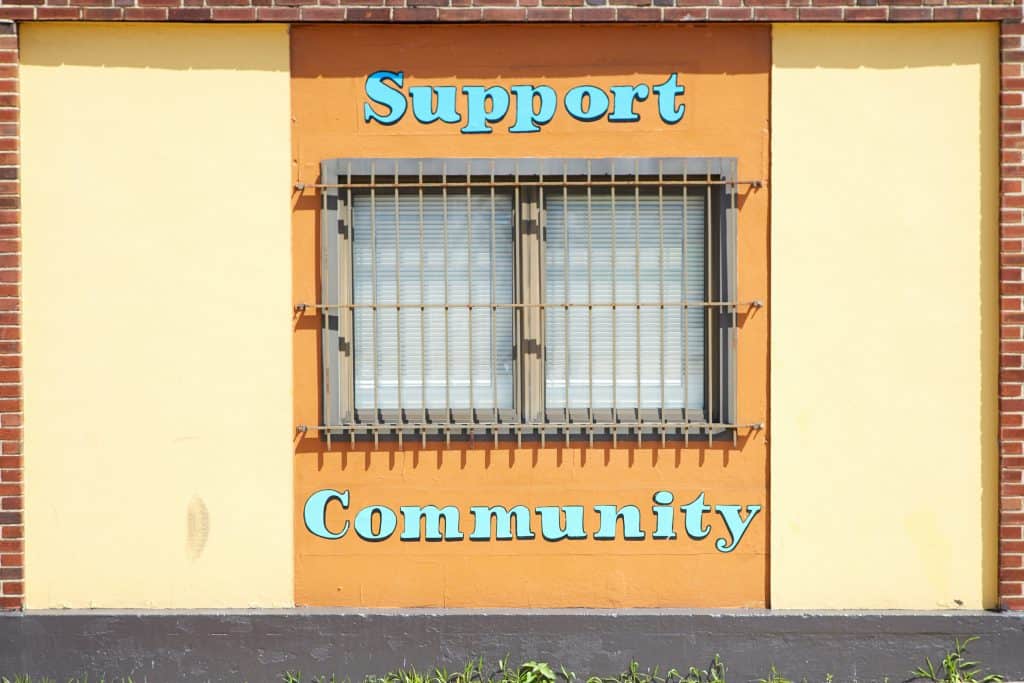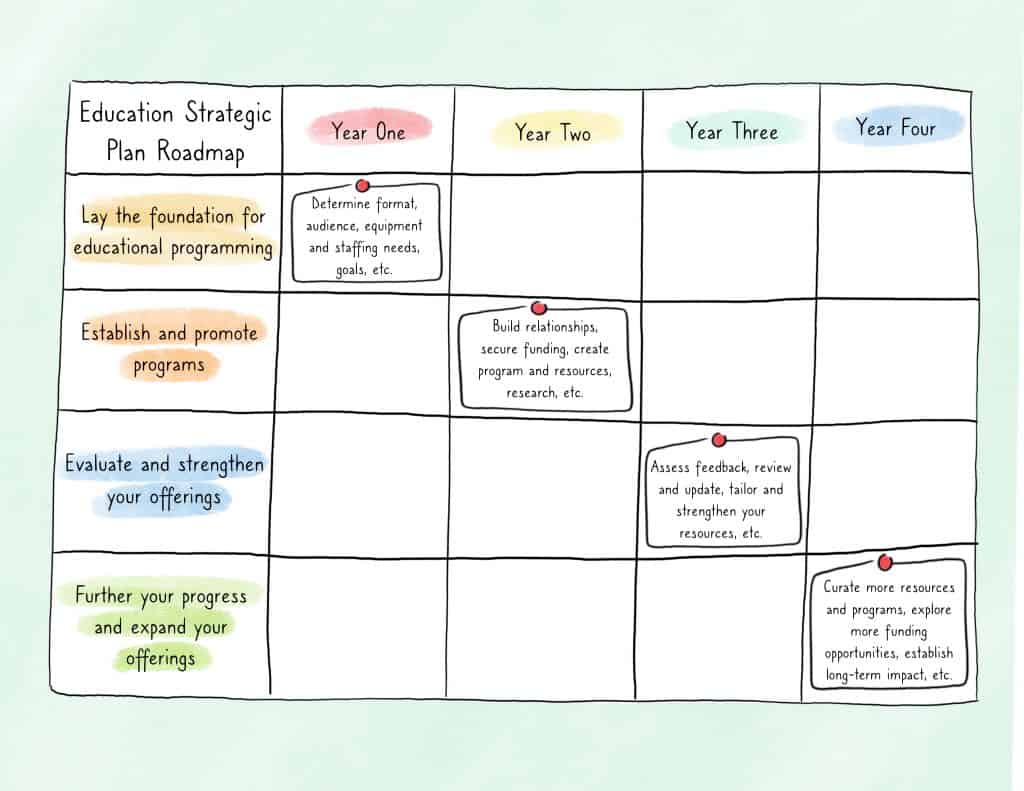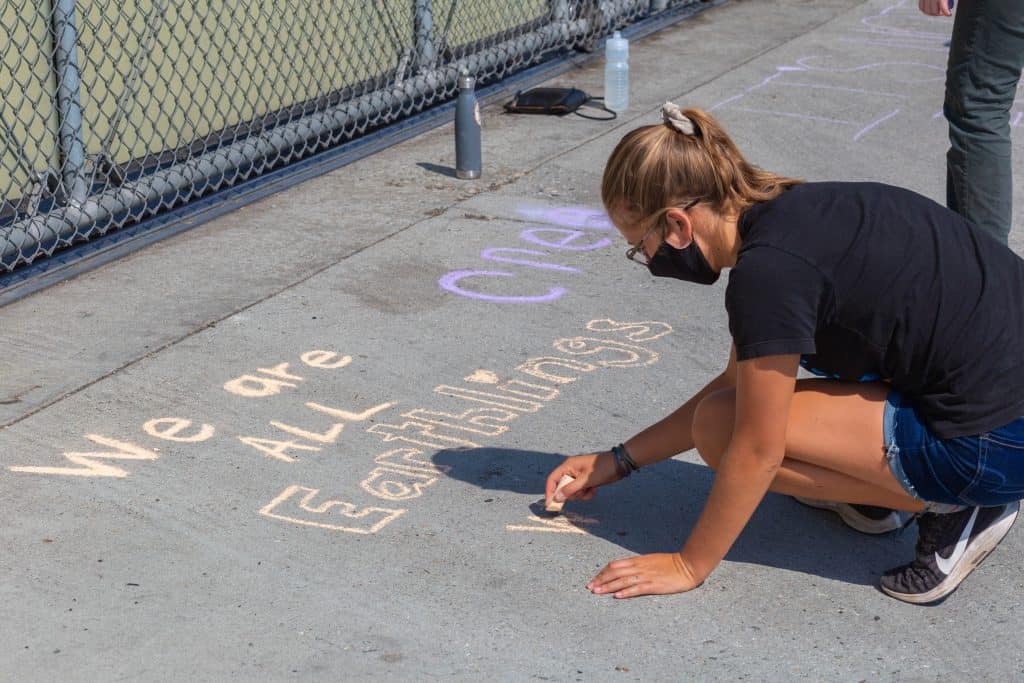
Introduction
Would you like to develop or improve your sanctuary’s educational programming, but you’re not sure where to begin? Let’s start by walking through some of the benefits of having an education strategic plan and outlining the steps needed to successfully create one that will help you implement a quality education program at your sanctuary.
What Is an Education Strategic Plan?
Like your organization’s more general strategic plan, an education strategic plan is an easy-to-read roadmap that describes where you want your sanctuary’s educational programming to be in 2-5 years. It identifies your educational programming objectives and the key strategies that will best enable you to achieve them. The education strategic plan will help you answer questions such as:
- What are your educational programming goals?
- How will you accomplish your educational programming goals?
- What needs to happen for your education program(s) to be a success?
- How will you measure programmatic success?
Why Is It Important to Have an Education Strategic Plan?
Having an education strategic plan is important for several reasons:
- Increased effectiveness: Having a plan will give you the ability to set priorities, make good decisions, stay focused, and take action when certain opportunities and challenges arise.
- Increased efficiency: Having a plan will enable you to spend less time and money on unimportant things while you’re developing and facilitating your education program(s).
- It will help you ensure excellence in your sanctuary’s educational programming and cultivate the partnerships required to enhance its impact.
- It will be incredibly useful for soliciting donors, philanthropic organizations, and granting organizations whose values may align with your program(s).
What Is Essential to Creating an Education Strategic Plan?
Form a Good Team

Before you create a plan, you’ll first want to put a good team together that will help facilitate the planning process. Your team should include a strong lead facilitator and a handful of other folks who understand your sanctuary’s mission and are committed to meetings, deadlines, equal participation, and conflict resolution. Regular communication is key.
Assess the Current State of Your Sanctuary, Education Program(s), and Community

Your team is going to start the planning process by reflecting on your sanctuary’s mission, vision, core values, and constituents. All these things will help you determine how your organization will approach education. You’ll then want to assess the current state of your sanctuary, education program (if applicable), and surrounding community. Understanding the current climate and circumstance of your organization will help you determine what type of education program is appropriate for your sanctuary and inform the strategies you implement to help you achieve your program’s goals. Let’s take a look at some of the questions you’ll want to consider together as you assess the current state of your sanctuary and its educational programming:
If you’re developing new educational programming:
Assess the needs of your community:
- What are similar nearby organizations doing in terms of educational programming?
- Are they doing it effectively?
- What challenges and opportunities have they faced? One way to answer this question is by interviewing and speaking with other organizations who have created education programs in a sanctuary setting. These will vary, of course, depending on your region and circumstance.
- How can you support or build on what they are doing?
- What can you do differently? What can you offer that isn’t currently being offered?
- Who is your audience? Who is around you? (examples: demographic, religion, industries, schools, etc.)
Assess the needs of your organization:
- What materials and resources do you currently have that will help you develop and implement an education program? Think about operations, facilities, equipment, technology, etc.
- What is your sanctuary’s staffing capability? Is it enough to implement and accomplish an education program?
- What funds do you currently have to develop and implement an education program?
- Take a look at our resources In-Person Sanctuary Educational Programming and Virtual Sanctuary Educational Programming for help determining what is possible for you.
If you already have educational programming:
Assess the needs of your community: Just like in a more general strategic plan for your organization, this could be researching the focus and effectiveness of your current education program(s):
- Are your programs serving the population you’re targeting effectively?
- Are similar nearby organizations doing the same thing, but more effectively?
- Why or why not? Find some actual quantitative data to make this case, as it will be instrumental in determining what changes you need to make and demonstrating how valuable your educational programming is.
- What can you do differently?
Assess the needs of your organization:
- What materials and resources do you currently have that allow you to implement your educational programming effectively? What materials and resources do you need to have to implement your educational programming more effectively? Think about operations, facilities, equipment, technology, etc.
- What is your sanctuary’s staffing capability? Is it enough for your current education program(s)?
- What funds do you currently have that allow you to facilitate your education program(s)? What funds do you need to facilitate your education program(s) more effectively?
Conduct a S.W.O.T. Analysis

A S.W.O.T. analysis is a close examination of your organization’s strengths, weaknesses, opportunities, and threats/challenges. It can be as simple as creating a list of any internal and external environmental factors that could affect your organization and its educational programming. Though it’s not mandatory to do, it’s important to process because it will inform your goal setting and prepare you for inevitable changes.
Examples of opportunities that might arise and influence your sanctuary’s education program(s):
- At some point, you may decide to expand and diversify your program offerings. How might you plan ahead for this financially, spatially, technologically, etc.?
- Positive public opinion and support requires program credibility and legitimacy. One way to do this is to form strong relationships with local schools, educators, and community organizations. You can also seek out recognition and public relations opportunities to promote your education programs and share your resources.
- Effective educational programming requires dynamic, engaging resources that are accurate and evidence-based. Seek out consulting support to develop more impactful programs.
- Education staff and volunteer retention is important. Sanctuaries require resources to support them. It’s important to provide professional development opportunities for your education staff.
Examples of threats/challenges that might arise and influence your sanctuary’s education programs:
- Limited access to financial resources: Securing adequate funding can be challenging. Competitive funding and dependence on grants impact program development and sustainability. Even if you currently have adequate funding for your educational programming, what will you do if your sources of funding change in the future? It’s important to secure funding (in the form of grants, donations, etc.) and plan for inevitable financial changes (example: Covid-19 outbreak). Clarity and transparency in your plan will help you do this.
- Accessibility barriers (Examples: language, location, terrain, lack of physical space, lack of access to schools, etc.)
- Lack of efficacy research in the field of humane education: Despite a deluge of important anecdotal evidence supporting the long-term impact of sanctuary education and humane education more generally, as well as academic research citing the importance of developing humane education values like empathy, unfortunately a great deal of empirical research demonstrating the efficacy and long-term impacts of such programs remains to be seen. This makes it all the more important for animal sanctuaries to conduct evaluative research that supports and improves sanctuary education and humane education programs!
- Many sanctuaries are overwhelmed with animal care and fundraising, leaving limited time for educational programming. It’s important to know what you can do in this moment. Don’t try to do any more than that.
Write Your Plan – Elements of an Education Strategic Plan

Cover Page
A cover page should have your organization’s name prominently displayed, your logo and color scheme, a title (“Education Strategic Plan”), and a date so everyone knows how up to date your plan is. It should also include key contact information in case any reader wants to get in touch with someone at your organization. You might also consider adding a confidentiality statement depending on what you’re writing about in the plan that includes whether you want the information to be reproducible. A sample confidentiality statement could look something like this:
This document includes proprietary and confidential information of and regarding [Your Organization’s Name]. You may not use this document except for informational purposes. You may not reproduce this document in whole or in part or divulge any of its contents without prior written consent from [Your Organization’s Name]. By accepting this document, you agree to be bound by these restrictions and limitations.
Table of Contents
A table of contents is a list of the different sections in this document followed by their corresponding page numbers.
Introduction/Summary
Your introduction should be a 1-2 paragraph summary of your education strategic plan. This should include what your organization wants to achieve in terms of educational programming (your goals and programs) and how it plans to get there. It should be simple and interesting to read. Most organizations find this section easiest to complete after they’ve finished creating the rest of the education strategic plan.
Education Program(s)
Describe your education program(s) in detail:
- Why will the program exist?
- How does it fit into your organization’s mission, vision, and core values?
- Who is the program for? (example: 7-13 year-olds)
- Where will the program take place? (examples: at your sanctuary, at the community library, online, etc.)
- What is the program’s timeframe? (example: two weeks each summer, every weekend, etc.)
- What is unique about your program?
Education Program Goals and Objectives
Explain your program’s goals and their connection to your sanctuary’s mission, vision, and core values. They will provide the framework that will guide the direction of your sanctuary education program through the allotted timeframe you set.
- Have specific goals: be clear and realistic.
- Quality over quantity: less is more.
- Within each goal’s section, include the expected outcome of the goal once it’s achieved.
Examples of objectives: To help visitors transition to a veganAn individual that seeks to eliminate the exploitation of and cruelty to nonhuman animals as much as possible, including the abstention from elements of animal exploitation in non-food instances when possible and practicable as well. The term vegan can also be used as an adjective to describe a product, organization, or way of living that seeks to eliminate the exploitation of and cruelty to nonhuman animals as much as possible (e.g., vegan cheese, vegan restaurant, etc.). lifestyle, create a sense of interspecies connection between humans and farmed animalsA species or specific breed of animal that is raised by humans for the use of their bodies or what comes from their bodies., and help visitors develop empathy for farmed animals
Implementation Plan
- Program: Onsite Sanctuary Tour
- Objective: To help visitors develop empathy for farmed animals
- Some tasks required to achieve this objective:
- Provide opportunities for visitors to safely observe your residents.
- Provide visitors with accurate species-specific knowledge that challenge harmful narratives in the media that are based in fear and prejudice. Share information that helps visitors understand how and why an animal behaves in a specific way. Draw on similarities between their experiences and our own.
- Intentionally choose your language. The language used to talk about an animal affects the development of empathy toward that animal. You are more likely to foster empathy if you introduce animals with names, stories, and unique personalities and needs.
- Provide space and time for visitors to talk about an animal’s personality and experiences in comparison and contrast to their own.
- How you interact with your residents and how you narrate those actions matter. Physically model the empathetic behaviors you want your visitors to develop.
- Engage in perspective taking dialogue.
- Positively acknowledge empathic comments, questions, and behaviors.
Break these tasks down into smaller tasks and include how you will provide each of these opportunities.
Example Task: Provide opportunities for visitors to safely observe your residents.
Sub-tasks to achieve this:
- Develop an accessible walking path that leads tour guides and visitors to resident enclosures.
- Establish protocols and practices that allow tour guides and visitors to safely observe and possibly interact with the residents.
- Provide accessible seating arrangements (e.g. benches) for visitors who want to observe the residents, but can’t stand for long periods of time.
Draw it Out
Many organizations find it extremely helpful to draw out and visualize their goals and implementation strategies.

Would this Roadmap template be useful for your Strategic Plan Roadmap? You can download a version ready to print and fill out yourself here!
Evaluation
Education program evaluation will help you determine whether you’ve achieved your educational programming goals. They show you how well (or not) your strategies helped to achieve your goals and empower you to improve your program(s) depending on the results. They are critical for guiding future decisions, building a strong evidence-based education program, and soliciting donors and grant organizations. To learn more, please check out our resource Education Program Evaluation for Animal Sanctuaries for an in-depth exploration of the evaluative process(es).
Conclusion
The conclusion to your education strategic plan is a clear summary of what you are trying to achieve in your educational programming and how you see the future of your educational programming. It can also include an invitation to your readers to help your organization make it a reality.
Appendix
The appendix is a supporting section containing useful and important information necessary in supplementing previously provided information. There is no limit to what you may include in this section:
- Job descriptions for key educator positions. Be clear about these roles. What are they doing?
- Recruitment and training for key educator positions
- Salary and wage breakdown for key educator positions
- Policies and procedures for safety during educational programming
- Budget: Costs that are specific to your unique programs and activities, such as: changes to the organization’s technology, facilities, and staffing that will be needed to successfully facilitate your education program(s). The cost should be broken down. This allows you to see the return on that program (e.g.: its impact, measurements, and success). A budget also provides clarity, shows your organization’s commitment to development, and gives donors the opportunity to fund the program if it’s something close to their heart.
Share Your Plan

Once you’ve finished creating your education strategic plan, share it with your entire team: staff, board, donors, volunteers, website visitors, etc. These are all members of your community that will help achieve your educational programming goals.
Operationalize Your Plan and Develop Your Educational Programming

Once your strategic plan is complete, it’s time to put it to use and take action! Schedule the work needed to accomplish the tasks on the plan and work the plan until you have accomplished all of the objectives you laid out and reached your educational programming goals.
Revisit, Revise, and Adjust Your Plan

Try to regularly review your plan with your staff and board members so you can respond to any changes that have taken place and adjust accordingly. This way, your sanctuary will be able to regularly identify, understand, and act on all the challenges and opportunities that will inevitably come your way. Many organizations review and revise their plans quarterly throughout the year. Remember, your education strategic plan is a living document. While it should remain connected and committed to your organization’s mission, vision, and core values, it should also grow and evolve with you as your organization changes!
Sources
Creating a Strategic Plan for Your Sanctuary | The Open Sanctuary Project








